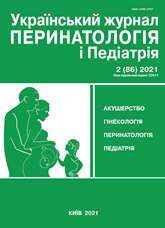Characteristics of the functional status of hemostasis in women after type I hysterectomy according to their body mass index
DOI:
https://doi.org/10.15574/PP.2021.86.24Keywords:
oncogenesis, deep vein thrombosis, clotting, obesity, complicationsAbstract
Neoplastic processes are a pathogenic trigger for the development of thrombotic complications, including deep vein thrombosis and pulmonary artery thromboembolism. Post-operative thrombosis is one of the leading mortality causes of oncological patients due to its asymptomatic course, and therefore due to the late diagnosis and treatment.
Purpose — to estimate the coagulation system condition in women after the type I hysterectomy depending on their body mass index.
Materials and methods. The study of hemostasis parameters of 50 patients with the uterus and uterine appendages oncological diseases depending on the body mass index was carried out. The results were processed by the method of variation statistics, which became the basis for their generalization. Calculations of the parametric Student's t-test and methods of nonparametric statistics (Mann–Whitney test) were used. Differences between comparable parameters were found statistically significant at p<0.05.
Results. The analysis of hemostasis parameters in oncological patients has revealed a twice higher concentration of fibrinogen and soluble fibrin monomer complexes in comparison to the control group. All three groups were characterized by hyperthrombocytopenia. The surgery provoked further activation of I, II, and III phases of coagulation on the background of negative thrombodynamics caused by intraoperative blood loss. In women with I and II obesity grade no statistically significant differences in coagulogram were observed, whereas in patients with III obesity grade the thrombotic potential was significantly more aggressive.
Conclusions. Oncological diseases of the female reproductive system are associated with the impairment of coagulation status: lower activated partial thromboplastin, hyperfibrinogenemia, and increased prothrombin index. The surgery was a significant trigger of the increase of hemostatic potential with the progressive increase of the markers of I, II, and III coagulation phases. III obesity grade is an independent risk factor for thrombotic complications.
The research was carried out in accordance with the principles of the Helsinki declaration. The study protocol was approved by the Local Ethics Committee of all participating institution. The informed consent of the patient was obtained for conducting the studies.
No conflict of interest was declared by the authors.
References
Abuzarova HR, Alentov YY, Anpylohov SV, Anurova OA et al. (2019). Oncology: National Guidlines. Moskow: GEOTAR-Media: 384.
Aksel EM, Vynohradova NN. (2018). Statistics on malignant neoplasms of the female reproductive organs. Onkohynekolohyia. 3: 64-78. https://doi.org/10.52313/22278710_2018_3_64
Aslam M, Oestergaard L, Bonde L, Gimbel H et al. (2018). Risk of infective endocarditis in women undergoing hysterectomy: a nationwide register-based cohort study. European Heart Journal. 39 (1): ehy563-P3536. https://doi.org/10.1093/eurheartj/ehy563.P3536
Cohen A, Lim CS, Davies AH. (2017). Venous thromboembolism in gynecological malignancy. International Journal of Gynecologic Cancer. 27 (9): 1970-1978. https://doi.org/10.1097/IGC.0000000000001111; PMid:28930804
Enhesari A, Honarvar Z, Moghadam SN. (2019). Comparison of the effect of compression stockings with heparin and enoxaparin in the prevention of deep vein thrombosis in lower limbs of hysterectomy patients. Revista Latinoamericana de Hipertension. 14 (1): 37-42.
Graul A, Latif N, Zhang X, Dean LT et al. (2018). Incidence of venous thromboembolism by type of gynecologic malignancy and surgical modality in the National Surgical Quality Improvement Program. International Journal of Gynecologic Cancer. 27 (3): 581-587. https://doi.org/10.1097/IGC.0000000000000912; PMid:28187092 PMCid:PMC5539959
Jorgensen EM, Li A, Modest AM, Leung K, Simas TAM, Hur HC. (2018). Incidence of venous thromboembolism after different modes of gynecologic surgery. Obstetrics & Gynecology. 132 (5): 1275-1284. https://doi.org/10.1097/AOG.0000000000002918; PMid:30303902
Li M, Guo Q, Hu W. (2019). Incidence, risk factors, and outcomes of venous thromboembolism after oncologic surgery: a systematic review and meta-analysis. Thrombosis research. 173: 48-56. https://doi.org/10.1016/j.thromres.2018.11.012; PMid:30471508
Mulder FI, Kraaijpoel N, Di Nisio M, Carrier M et al. (2020). Edoxaban for treatment of venous thromboembolism in patient groups with different types of cancer: Results from the Hokusai VTE Cancer study. Thrombosis research. 185: 13-19. https://doi.org/10.1016/j.thromres.2019.11.007; PMid:31733403
Nagase S, Ohta T, Takahashi F, Enomoto T. (2019). 2017 Committee on Gynecologic Oncology of the Japan Society of Obstetrics and Gynecology. Annual report of the committee on gynecologic oncology, the Japan Society of Obstetrics and Gynecology: annual patients report for 2015 and annual treatment report for 2010. Journal of Obstetrics and Gynaecology Research. 45 (2): 289-298. https://doi.org/10.1111/jog.13863; PMid:30426591
Vitale SG, La Rosa VL, Rapisarda AMC, Lagan? AS. (2017). The importance of fertility preservation counseling in patients with gynecologic cancer. Journal of reproduction & infertility. 18 (2): 261-263.
Wright JD, Matsuo K, Huang Y, Tergas AI, Hou JY et al. (2019). Prognostic performance of the 2018 International Federation of Gynecology and Obstetrics cervical cancer staging guidelines. Obstetrics and gynecology. 134 (1): 49-57. https://doi.org/10.1097/AOG.0000000000003311; PMid:31188324 PMCid:PMC7641496
Downloads
Published
Issue
Section
License
The policy of the Journal “Ukrainian Journal of Perinatology and Pediatrics” is compatible with the vast majority of funders' of open access and self-archiving policies. The journal provides immediate open access route being convinced that everyone – not only scientists - can benefit from research results, and publishes articles exclusively under open access distribution, with a Creative Commons Attribution-Noncommercial 4.0 international license(СС BY-NC).
Authors transfer the copyright to the Journal “MODERN PEDIATRICS. UKRAINE” when the manuscript is accepted for publication. Authors declare that this manuscript has not been published nor is under simultaneous consideration for publication elsewhere. After publication, the articles become freely available on-line to the public.
Readers have the right to use, distribute, and reproduce articles in any medium, provided the articles and the journal are properly cited.
The use of published materials for commercial purposes is strongly prohibited.

